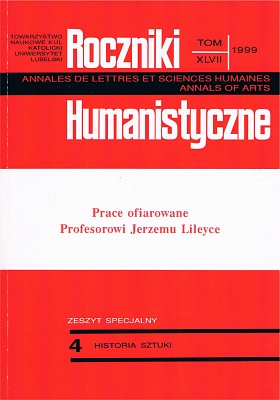Some Reflections on the Portraits of Learned Humanists in the Renaissance Painting on the Example of the Portrait of Paracelsus in the Louvre
Abstract
The problem of the portrait of the humanist has already been explained in formal terms as „a scholar in his study”, taking into consideration the significance of his bodily characteristics and the place in which he has been presented. Understood in this way the portrait becomes part of a series of portrait models explained within the type of a defined social group. Recent research into portrait in the Renaissance reveals that painters undertook attempts at showing also personality features of the presented people, and not only physical ones. Beginnings of such creation of figures have been pointed to, which are seen in the portraits of condottieres, whose physical strength was united with the inner strength of their character. Personalities of humanists also belong to this type. In the second half of the 15th century painters from Florence and Venice worked out a way of showing figures with inner strength. Landscape was harmonised with them in order to deepen the illusions sought for the models of the portrayed people. They may serve as comparison for the Louvre portrait of Paracelsus ascribed to Q. Massys, which is discussed in the present paper. The figure was shown in a way that integrates the man's fisis and psyche, in this way reproducing the real personality of the great doctor and humanist. The landscape is harmonised with the presented figure model; despite the illusion of uniformity it was de facto composed of many different topographic elements. It was intentionally composed as a spatial mosaic, so that the effects sought for the human figure could be brought out.
Portraits painted against the background of landscape have their long tradition in the Dutch painting, starting with Jan van Eyck. However, the painters belonging to the later Antwerp school of the first quarter of the 16th century took up the problem again, accepting the character of landscape as an element that is integral with the figure of the portrayed humanist. Models for this type of painting were taken from Italian portraits they knew from their immediate experience. Painters more and more often crossed the Alps, consciously looking for inspiration there. Jan Scorel belonged to these painters. His paths of creative penetration followed traces of Paracelsus' life and work until the artist started work in Rome, at the court of his friend from Utrecht – Hadian VI. The portrait of Paracelsus shows the painter's knowledge of the art of the portrait as physical creation combined with attempts at rendering his inner personality. The type of landscape also has the features of southern painting, especially Tuscanian, which to a considerable degree introduced toposes of the ideal landscape with features of idyll inspired by poetical texts.
The portrait of Paracelsus fits the rich tradition of „scholar against the background of landscape”, creating a harmony of the personality and the ideal place described in ancient texts. The Antwerpian humanism not only sought formal patterns for solving artistic problems, but it penetrated deeper connections with Italian humanism in literature, which was analysed in the work by Larry Silver. The problem of the portrait of Paracelsus discussed here may be an example of the Renaissance understanding of the humanist against the background of landscape.
Copyright (c) 1999 Roczniki Humanistyczne

This work is licensed under a Creative Commons Attribution-NonCommercial-NoDerivatives 4.0 International License.





